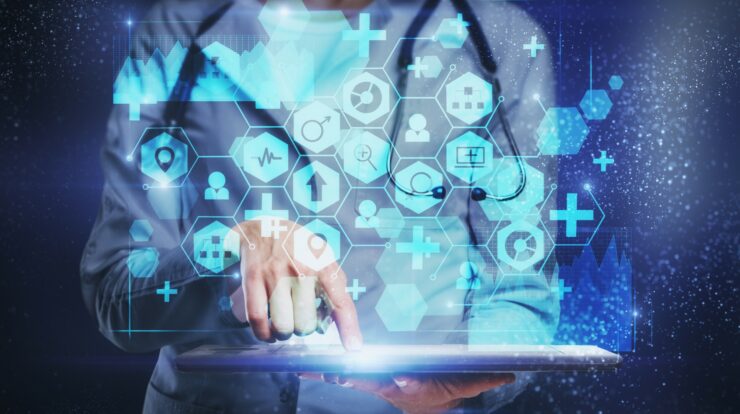
Enter the AI-controlled doctor, surgeon, and nurse in today’s healthcare settings. Some hospitals are already experimenting with AI-enabled innovations that can help to reduce pressure on healthcare professionals, optimize workflows, free them from repetitive tasks that are time-consuming and tedious. Powerful AI algorithms can also help support the clinical decision-making process.
Will AI be the solution to our physician and nurse shortages?
Populations are increasing across the world but the bulk of the burden of healthcare is on the quickly burgeoning aging population and the increase in chronic ailments. There are just not enough physicians and nurses to go around. Hospitals are understaffed and healthcare costs are rising leading to poor patient outcomes.
With the promise of hope that AI will be able to ameliorate some of challenges healthcare is facing today, AI-powered platforms and even AI-enabled robots are receiving a warm welcome.
How will AI help doctors and nurses?
In the next decade, telehealth technology companies will bring in new innovations with high-performing AI algorithms, IoT, and 5G technology. AI is making significant strides in the health sector optimizing workflows, building transparency, introducing innovation, and providing predictive analysis that may help to prevent disease in the near future. According to a McKinsey report, AI medical devices integrated with patient workflow can increase the productivity of healthcare professionals by 30% to 50%.
Predictive analysis – With AI’s power to analyze huge data sets in minutes recognizing patterns can help doctors to predict what will happen next leading to a more proactive healthcare system. For instance, in the case of diabetic patients. Predictive analytics can foretell the highest probability of hospitalization based on various factors such as age, onset of disease, gender, weight, co-existing illness, and adherence to medication. When doctors have this kind of information at their disposal, it can help them to make better decisions for better health outcomes of their patients. Predictive analytics can also be used in population or community health management programs such as was done during the Covid-19 pandemic to contain the spread.
Brain computer interfaces – They’re called brain chips and they’re backed by AI. When implanted in the brain it can help restore the ability to communicate in those who have lost speech and movement ability. It is extremely useful for people with ALS, strokes, or locked-in syndrome, as well as people with spinal cord injuries. Scientific American published an article in May 2021 describing this break-through technology which enables “people with paralysis perform thought dictation at rates approaching the thumb speeds of texters.”
AI-Enabled Radiology – About 97% of radiology departments in the United Kingdom are not able to meet their reporting requirements, according to a 2018 report by Care Quality Commission. Integrated systems and solutions focused on intelligent data-driven approach result in informed practice management saving time and helping radiologists make quicker decisions. Next-generation radiology tools are being developed that are so accurate and detailed that they can replace the need for tissue samples in some cases allowing clinicians to base their treatment decisions on how tumors behave as a whole instead of depending on small segments retrieved from a tissue sample.
Robotic-arm surgery – This type of surgery enables surgeons to perform minimally-invasive surgeries with more precision and flexibility. Closing sutures with robotic AI tools can augment a surgeon’s ability. Robotic-arm surgery has resulted in quicker recoveries and improved patient outcomes. AI robotics surgery can help surgeons determine what is happening during surgery by providing real-time data points about movements. Machine learning can help uncover critical insights from millions of data points associated with robotic-assisted surgery.
Patient Diagnostics – AI is being used in patient diagnosis. A study conducted by the Mayo Clinic revealed that doctors could be wrong about a diagnosis of a serious condition by as much as 20%. AI-powered apps can help doctors determine diagnosis with higher accuracies. Combined with machine intelligence, the accuracy of the assessment can be as high as 85% of the time thus keeping human error to a minimal. Already GS Lab has developed an app that has harnessed voice samples to diagnose health issues. This is a screening and monitoring platform based on speech analysis and can be used over the phone.
Can AI really replace doctors and fix the doctor shortage?
AI cannot and will never replace doctors any time in the near future but it can help doctors treat more people, more accurately. China has a shortage of ophthalmologists. In 2017, a city in China opened its first clinic to diagnose cataracts using an AI-powered tool that can diagnose cataracts in patients and direct them toward the best specialist based on their needs. The tool relieved doctors of preliminary exams, saving time and enabling more patients to be treated.
Investing in the AI market in healthcare
The global AI in healthcare market size is expected to grow at a phenomenal rate of 45% from 2020 to 2026 reaching USD 45 Billion. Healthcare systems are encouraged to start making investments in AI to remain competitive in a fast-accelerating tech landscape.


